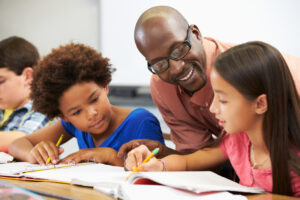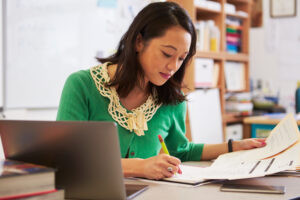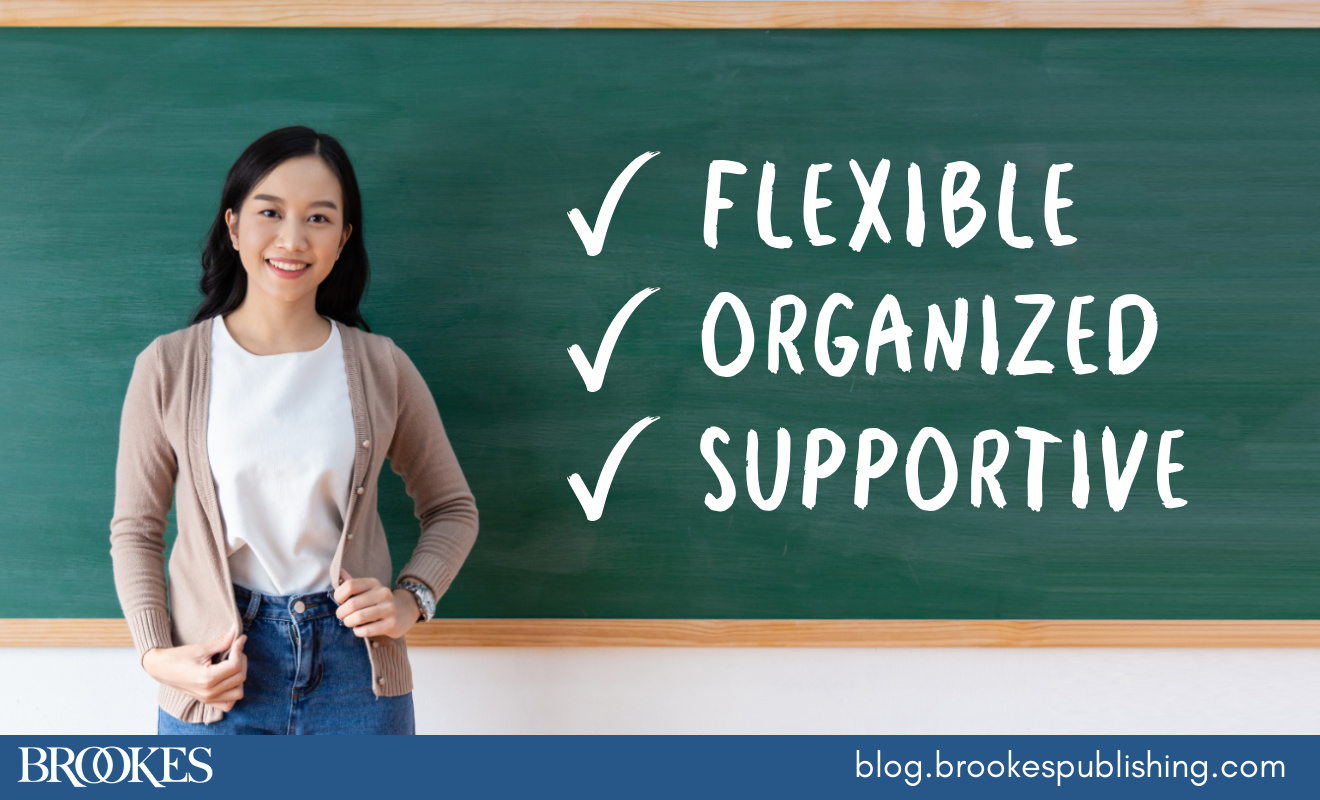Teacher Tips: Expert Advice on Organizing Your Classroom
January 24, 2023
 Skillful classroom organization helps break down barriers that prevent students from becoming expert learners. Excerpted and adapted from the fourth edition of Multisensory Teaching of Basic Language Skills, from a chapter by Judith R. Birsh, Jean Schedler, and Robin Anderson Singer, today’s blog post offers expert guidance. Teachers, read on for some great tips on organizing your instructional spaces, traffic patterns, and classroom materials!
Skillful classroom organization helps break down barriers that prevent students from becoming expert learners. Excerpted and adapted from the fourth edition of Multisensory Teaching of Basic Language Skills, from a chapter by Judith R. Birsh, Jean Schedler, and Robin Anderson Singer, today’s blog post offers expert guidance. Teachers, read on for some great tips on organizing your instructional spaces, traffic patterns, and classroom materials!
Tips for organizing…Your main teaching space

The main teaching space is your first space to plan. Begin by standing in the space and mentally listing available classroom furniture (desks, file cabinets, tables, whiteboards, Smart boards, easels, bulletin boards, shelves, cubbies). Ask yourself these questions:
- Where will you stand during the major portion of classroom instruction (or sit, if it is a small-group setting)?
- Where are the boards located in relation to you?
- Where will the other teaching equipment (e.g., easels, projectors) used during daily instruction be placed?
- How can student desks be arranged so that all students can see you during instruction? What works best for you and them—desks in rows, touching, or in a four-square pattern?
- Are desks the correct size for your students? Students should be able to sit comfortably with their feet flat on the floor and knees not hitting the bottom of the desk. You may need to trade desks with other teachers or add wooden boxes for your shorter students to rest their feet.
- Where will students keep their books and supplies? Do you want them to keep their materials in their desks? If lockers are available, what will be kept in them? Even if the desks have space for supplies, you may still want to have students keep supplies and books in an assigned tote in the classroom so that during instruction they have only the needed materials at their desks.
Tips for organizing…Your personal space

Organizing a teacher’s personal space is often overlooked, but it is so critical for effective, efficient instruction. First, decide where to place and how to situate the teacher desk(s), filing cabinets, and bookcases to be used exclusively by you and/or classroom assistants. It’s often a good idea to locate the teacher desk(s) and confidential materials away from the student traffic pattern. If you plan to have students sit with you at your desk for individualized instruction, plan how that area will work as well.
Next, think of all the requests made of you by students, administrators, colleagues, student teachers, and parents. You’ll need to have easy access to documentation that may be requested by school personnel and supervisors. Students often request materials such as paper, tape, scissors, passes, and forms. If you store these items on your desk, consider how to make them readily accessible without students accidentally having access to confidential materials. Take time to set up separate folders or files (on a computer if possible) for confidential student information, information for parents, routine memos from the administration, and committee information.
Your plan for organizing your desk, drawer space, and desktop supplies, as well as setting up any filing cabinets, bookcases, and storage closets, needs to be well thought out for accessibility and keeping daily clutter to a minimum. Make your personal space efficient so you don’t dread sitting down to a disheveled desk at the end of a productive day. Having everything organized ensures the items are readily accessible and don’t become distractions or disruptions to the lesson.
Tips for organizing…Teaching materials
At the beginning of the year, set up labeled shelves or containers to accommodate materials critical to the success of your lessons. Each group or student should have core daily lesson materials in a clearly marked bin, which could also contain card decks for teaching new concepts and reviewing, current reading lists, workbooks, manipulatives, extra pencils, and index cards. Student notebooks should be nearby.
 For older students, it’s helpful to number electronic devices and assign each student a specific one. Provide a labeled storage box that can hold the entire set of electronic devices at the end of the lesson, and store them in the same place on the shelf for the year. Setting up computers and scheduling time for your students to practice and review should become part of the learning process.
For older students, it’s helpful to number electronic devices and assign each student a specific one. Provide a labeled storage box that can hold the entire set of electronic devices at the end of the lesson, and store them in the same place on the shelf for the year. Setting up computers and scheduling time for your students to practice and review should become part of the learning process.
Teachers, as well as students, have transitions in their academic day—from subject to subject, from instructional group to instructional group, from one discrete instructional component to the next within a lesson. In addition to making sure you have all materials needed for a lesson, spend time planning what you’ll do with teacher and student materials at the end of a specific lesson or component so that the next subject or instructional group can be initiated efficiently. Enclosed plastic folders with multiple sections are ideal for holding things like letter tiles, writing boards, and composition books.
Tips for organizing…Classroom traffic patterns
 Once different classroom areas of use have been identified and the furniture is placed, check the traffic patterns that result from the current placement of furniture. Ask the following questions:
Once different classroom areas of use have been identified and the furniture is placed, check the traffic patterns that result from the current placement of furniture. Ask the following questions:
- Are students able to enter and exit the classroom without bumping into desks, bookcases, and tables stacked with papers?
- Is the teacher’s desk still situated so that it will be undisturbed by students?
- Is there still a place to easily store and gain access to confidential information, such as tests and progress reports, away from students?
- Where do students place papers they are handing in for grading? Is this working well?
- Are the pencil sharpener, other classroom supplies, and trash can optimally located?
- Is there a space or desk set off as a quiet corner if needed?
Take a critical look around the room with an eye toward limiting classroom distractions and maximizing efficiency. Finding what works best may take several attempts, as you fine-tune to meet your needs as a teacher and your students’ needs for logical, systematic order in the classroom’s physical environment.
***
Taking the time to get your classroom space and materials organized will help you lay the groundwork for a productive classroom environment. While your plan for organizing must be carefully thought out, keep in mind there’s no one right plan or organization to any given space. The plan must work for you as the teacher and for the specific students assigned to it. Make adjustments throughout the year as you figure our what systems work best in your classroom!
Multisensory Teaching of Basic Language Skills, Fourth Edition
 Edited by Judith R. Birsh, Ed.D., CALT-QI, & Suzanne Carreker, Ph.D., CALT-QI
Edited by Judith R. Birsh, Ed.D., CALT-QI, & Suzanne Carreker, Ph.D., CALT-QI
The most comprehensive text available on multisensory teaching, this book prepares today’s educators to use specific evidence-based approaches that improve struggling students’ language skills and academic outcomes in elementary through high school.




Write a Comment
Your email address will not be published. Required fields are marked *
Post a Comment